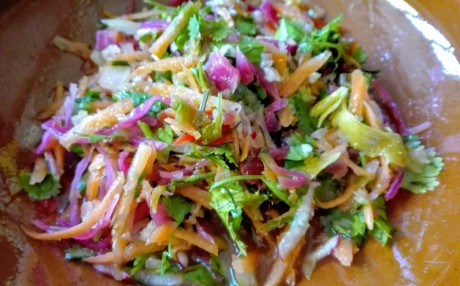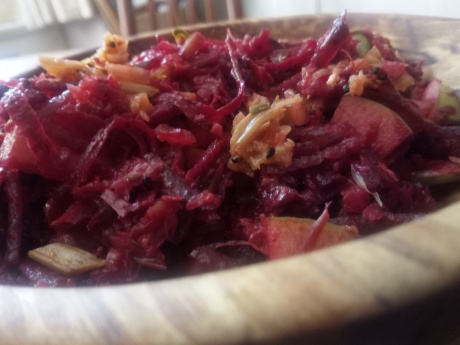
Shredded CARROTS and RADISHES, RUBYKRAUT, PICKLED CHILLIS and CELERY, CORIANDER, DILL, OIL and SCRAP APPLE BLACKBERRY VINEGAR.
Often when I teach workshops, participants seeking the health benefits of fermented foods ask about consuming them: how do we eat these foods? how do we incorporate them into our diet, our day, our meals? How do we use the ferments we make?
So I launch into my talk on the variable use of the word “pickle” and the idea of a savoury morsel, and sauerkraut and kimchi as foods that go as condiments or digestives or piquant flavour-rounders with many other foods. And of course you can cook with ferments, and traditionally around the world many functioned to preserve raw ingredients later to be be used in cooked dishes like soups and stews. I explain how I like to toss kraut and small pieces of pickles in green salads, and sometimes to puree them in dressings, and to add probiotic, succulent brine to bolster flavour and acid. Raw is good for maximum bacterial benefit.
Lately I’ve been layering ferments in root vegetable salads. These salads are nourishing, delicious, filling, and can be invented truly from what’s on hand in a well-stocked kitchen of local and seasonal ingredients. If you find yourself fermenting, then you’ll have interesting, creative fermented elements to incorporate, for endless possibilities, into your meals.
The formula I’ve been obsessed with is so basic: shredded roots, layered with a ferment and fresh herbs, then dressed. And add whatever you like. Proportions are yours to decide. Leftovers are yours to use up. Alliums, garlic, ginger and spices– yours to choose.
Here are a few salads I’ve made recently on this theme.
————————-

Shredded BEETROOT and LEEK, RED ONIONS, SAUERKRAUT w white cabbage, spring greens, radish tops, coriander and cumin seed and ginger, PARSLEY, RED PEPPERS, Olive Oil and Vinegar.

SWEDE (rutabaga), CARROT, KIMCHI with dandelion, cleavers, alexanders, chives, CORIANDER LEAF, DILL, YELLOW and RED PEPPERS, OLIVE OIL, LEMON JUICE, SESAME OIL.

SWEDE, CARROT, LEEK, CELERY, some smashed PRESERVED LEMON, SAUERKRAUT, DILLWEED, AVOCADO, the TURMERIC-Y BOTTOM of a JERUSALEM ARTICHOKE PICKLE, Olive Oil. (Fish would have been so nice in this!)









